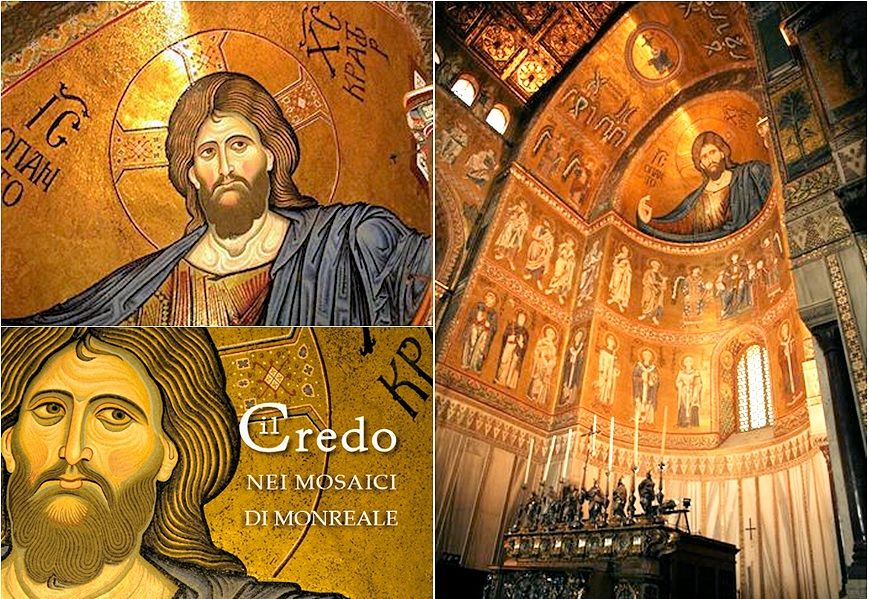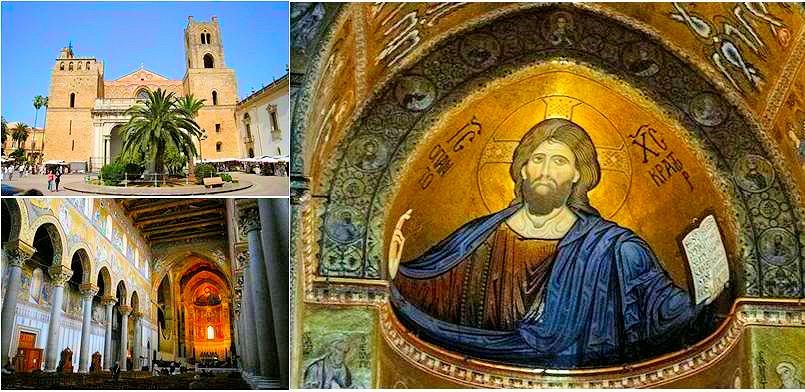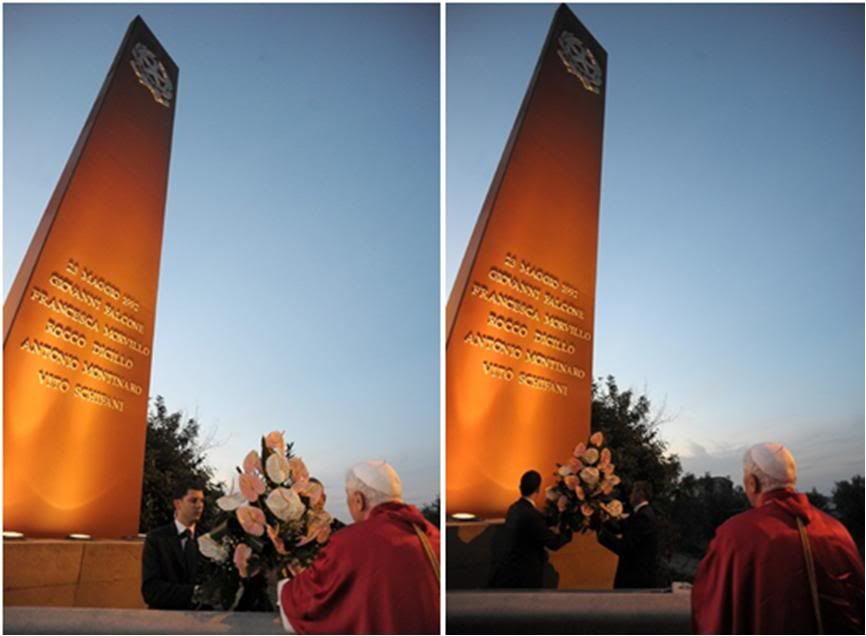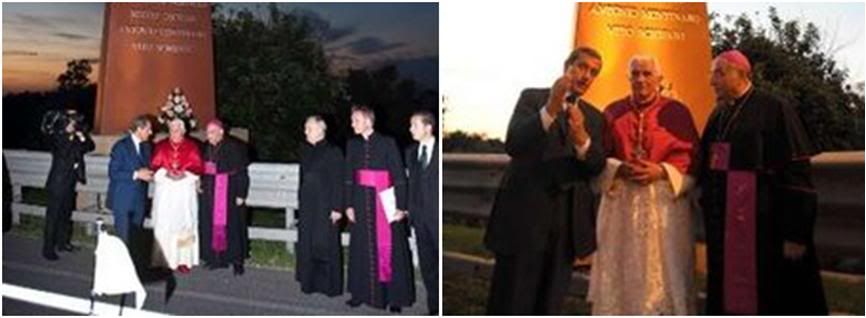 The most beautiful 'Credo' mosaics
The most beautiful 'Credo' mosaics
in the world are in Monreale near Palermo
The articles of Christian faith illustrated in 7,000 square meters of wonderful 12th-century mosaics.
A series of broadcasts on TV 2000 starting April 21 will present them to the viewer as never before.
by Sandro Magister
From the English service of

ROME, April 18, 2008 – In his last Wednesday general audiences, before renouncing the papacy, Benedict XVI had begun to explain the Credo, the Christian profession of faith. His successor, Francis, has decided to continue the work.
[I had been meaning to make a small comment on this earlier, but did not have the appropriate opening to do so. Benedict XVI started his catecheses on the Credo, reflecting on its first three articles, "I believe in God", 'the Father almighty", and 'creator of heaven and earth", before he stepped down as Pope. He would have resumed with "...and in Jesus Christ, His only Son, our Lord" - the essence of the Christian faith (and I have no way of telling whether he would have treated the line in one catechesis or three). Pope Francis resumed the catecheses on the Credo at his second GA on April 3, the Wednesday after Easter (his first GA had been dedicated to the significance of the Holy Week liturgies). But he picked up from "the third day he rose again from the dead", presumably because of its liturgical timeliness. That meant that he skipped - unless he plans to go back in the sequence - the part from "and in Jesus Christ, his only Son, our Lord, who was conceived of the Holy Spirit, born of the Virgin Mary, suffered under Pontius Pilate, was crucified, died and was buried...", namely, the entire part about the incarnation of Jesus and his human life. Go figure...]
The Credo is the first breath of the newborn Christian. It is all of a piece with Baptism, it is proclaimed at Sunday Mass, it is the identity card of the believer. “The faith is as we say in the Credo,” Pope Francis reiterated in a recent morning homily. The whole faith - he added - without subtractions, without reductions, without compromises.
This is the reason that - in this Year of Faith - induced TV 2000, the channel of the Italian episcopal conference, to put the Credo at the center of an original series of broadcasts, beginning on Sunday, April 21.
But how? With the forms, the colors, the light of that masterpiece unique in the world which are the mosaics of the cathedral of Monreale, in Sicily.
In twelve episodes like the twelve apostles, Sunday after Sunday, each article of the Credo will be narrated and presented to the viewer from inside that very cathedral, illuminated by its wonderful mosaics from the 12th century.
The narrator will be Fr. Innocenzo Gargano, a Camaldolese monk, a master of the Sacred Scriptures and the Fathers of the Church. A narrator in the proper sense of the word.
Because the Credo is not an arid list of dogmas. It is the living history of the action of God with men and for men. It is "historia salutis" with its summit in the Christ "Pantocrator" that dominates the apse of the cathedral of Monreale.
Step by step, from inside the cathedral, Fr. Innocenzo will unveil the “spirit” of the images and therefore of the sacred narration, following the outline of the articles of the “Credo.”
He will alternate with the art historian Sara Magister, who will illustrate the “letter,” the iconography of the same images, from the studios of TV 2000 in Rome.
One will thus embark upon an adventure without equal, from the first moments of creation to the coming of Jesus to the heavenly Jerusalem. An adventure revisited precisely in the place in which these same images become sacramental reality, when the Eucharist is celebrated on the altar.
More than eighty years ago the cathedral of Monreale was visited by Romano Guardini, an Italian-German theologian very dear to Joseph Ratzinger and Jorge Mario Bergoglio.
Guardini attended the rites of Holy Week in the packed church, and was struck by the attitude of the faithful: "The women with their veils, the men with their cloaks around their shoulders. Everywhere could be seen distinguished faces and a serene bearing. Almost no one was reading, almost no one stooped over in private prayer. Everyone was watching intently, everyone was rapt in contemplation."
The director of TV 2000, Dino Boffo, said in presenting the new program: "The believers who over the past nine centuries had the opportunity to turn their gaze upward and admire the mosaics of the cathedral of Monreale were for the most part illiterate, but not for this reason fatally destined to remain in ignorance. The nourishment of the faith came through the charm of the beautiful, of the majestic. 'One day we will look upon that beautiful face of the Risen One,' Pope Francis said to the cardinals who had just elected him. And so, one foretaste of that unfathomable beauty is precisely in the vault of the apse of Monreale, where the mosaics that decorate the walls of the cathedral converge.”
The twelve episodes of “Il Credo nei mosaici di Monreale," each of them half an hour long, will be broadcast every Sunday at 8:30 in the morning and replayed at 3:30 pm.
The first episode, on Sunday, April 21, will illustrate the first article of the profession of faith: “I believe in God, the Father almighty, creator of heaven and earth.”
TV 2000 can be seen in Italy on cable channel 28 and satellite channel 142 of Sky.
But the program can also be seen via streaming all over the world, on the website of the channel
www.tv2000.it/ Afterwards, all of the episodes will be available on YouTube.
 "Il Credo nei mosaici di Monreale" is a program created by Sandro Magister and Fr. Innocenzo Gargano.
"Il Credo nei mosaici di Monreale" is a program created by Sandro Magister and Fr. Innocenzo Gargano.
The artistic commentary is by Sara Magister.
The producer is Francesca Romana Pozzonelli.
The director of the filming in the cathedral of Monreale is Davide Gambino of Run To Me Film.
The director in the studios of TV 2000 is Edoardo Pacchiarotti.
The evocative soundtrack of the broadcast is made up of Gregorian chant, beginning with the hymn of the title sequence: "Urbs Jerusalem beata".
 Allow me a little digression. When Benedict XVI made a pastoral visit to Palermo in October 2010, AGI's Salvatore Izzo recounted his visit to Palermo as Cardinal Ratzinger, at the invitation of the then Archbishop of Palermo, Cardinal Di Georgi (whom Benedict XVI would choose 13 years later as one of the three cardinals he requested to conduct an internal inquiry on Vatileaks and present a report on the Curia).
Faith, words and art:
Allow me a little digression. When Benedict XVI made a pastoral visit to Palermo in October 2010, AGI's Salvatore Izzo recounted his visit to Palermo as Cardinal Ratzinger, at the invitation of the then Archbishop of Palermo, Cardinal Di Georgi (whom Benedict XVI would choose 13 years later as one of the three cardinals he requested to conduct an internal inquiry on Vatileaks and present a report on the Curia).
Faith, words and art:
Joseph Ratzinger's previous
visit to Palermo
Translated from

It was Benedict XVI's first visit to Palermo as Pope. But not his first. When he was the Prefect for the Congregation for the Doctrine of the Faith, Cardinal Joseph Ratzinger flew to Palermo for a visit that remains in the annals of the city.
It was March 13, 2000 - during the Grand Jubilee Year, no less - and he had been invited by Cardinal Salvatore De Giorgi, then Archbishop of Palermo, to inaugurate the 'Week of Faith' in Palermo Cathedral.
The bioethical challenge, inter-religious dialog, the task of Catholic missions, and of course, God-become-man, were the themes that the cardinal spoke about to an audience of 1,500 who well remember his lecture, even if at the time, it was farthest from anyone's mind that the lecturer would be Pope in five years!
His hosts also remember how fascinated he was, looking up enrapt at the magnificent mosaics of the Cathedral in Monreale. He was impressed by the beauty and fidelity to Scripture of the scenes depicted in the mosaics and stunned by Monreale's great Christ-Pantocrator on the dome, just as he was utterly enchanted by the jeweled wonders of the Cappella Palatina in the Palace of the Normans.
It was a taste of Sicily which must surely have stayed in his heart.
At the time, I was wondering how I could work in Monreale into the coverage of the Palermo visit, and Izzo's item gave me the opening. Forgive the indulgence, but one cannot go to Palermo and not visit Monreale, which is a short trip by public bus outside the city.
 Do not be deceived by the exterior. The whole church-monastery complex was first built in the late 12th century and is considered the best amalgam of Norman, Byzantine and Arab architecture from that time. Its Benedictine cloister is arguably the world's most beautiful, best preserved and largest medieval cloister. And yet its exquisite adornment almost pales compared to the 6,600 square meters of mosaic work, representing the most extensive extant cycle of Biblical illustrations, that covers the church interior. (Only Hagia Sophia in Istanbul had a greater mosaic area, but much of it, of course, has been lost.) When one contemplates the mosaics of Ravenna, Santa Maria Maggiore and Monreale, one realizes that mosaic artists are the most under-rated in the visual arts. It is mind-boggling to think how they can manage to put together the thousands of colored glass bits to produce the seamless artistry that they do. I find the Christ Pantocrator (Almighty) of Monreale as stunning as the Christ in Michelangelo's Last Judgment. (It's as high as a four-story building, to begin with). But, of course, Monreale is more than just its mosaics, as awesome as they are....
Do not be deceived by the exterior. The whole church-monastery complex was first built in the late 12th century and is considered the best amalgam of Norman, Byzantine and Arab architecture from that time. Its Benedictine cloister is arguably the world's most beautiful, best preserved and largest medieval cloister. And yet its exquisite adornment almost pales compared to the 6,600 square meters of mosaic work, representing the most extensive extant cycle of Biblical illustrations, that covers the church interior. (Only Hagia Sophia in Istanbul had a greater mosaic area, but much of it, of course, has been lost.) When one contemplates the mosaics of Ravenna, Santa Maria Maggiore and Monreale, one realizes that mosaic artists are the most under-rated in the visual arts. It is mind-boggling to think how they can manage to put together the thousands of colored glass bits to produce the seamless artistry that they do. I find the Christ Pantocrator (Almighty) of Monreale as stunning as the Christ in Michelangelo's Last Judgment. (It's as high as a four-story building, to begin with). But, of course, Monreale is more than just its mosaics, as awesome as they are....

 In the same post, however, I found this item - totally unrelated to Monreale - which has taken on added significance for me, besides the intrinsic value of Benedict XVI's gesture:
Pope makes unscheduled stop
In the same post, however, I found this item - totally unrelated to Monreale - which has taken on added significance for me, besides the intrinsic value of Benedict XVI's gesture:
Pope makes unscheduled stop
to lay flowers at monument to
a judge killed by the Mafia
Translated from

October 3, 2010

During the ride from Palermo to the Falcone-Borsellino airport in Punta Raisi, the Pope asked that the motorcade stop at Capaci, at the point where Judge Giovanni Falcone and his escorts were assassinated in 1995.
He left the car to place a bouquet of flowers on one of the marble steles ercted to commemrorate the victims and offered a prayer for all the victims of the Mafia and other forms of organized crime.
The motorcade then proceeded to the airport and the flight back to Rome.

The Falcone-Borsellino airport is, in fact, named for Judge Falcone and one other judge who was also assassinated by the Mafia.
The new significance of this episode for me is that even if this was an unprogrammed stop at a roadside monument, on his way to the airport to return to Rome, Benedict XVI honored the occasion enough to wear a ceremonial mozzetta and put on choir dress to pay his homage to the martyred judge.
Do you suppose Pope Francis will ever wear choir dress? (But wait, he wore one for the Conclave, along with the requisite red cardinal's mozzetta! He was one of the few cardinals I remembered to look out for at the time they made their individual oaths on the Bible in the Sistine Chapel before the Conclave began. If choir dress was acceptable to him for the Conclave, why did he not continue wearing it over his brand-new papal white cassock, along with the papal mozzetta, for his first loggia appearance? Suppose he held his first consistory - will all the cardinals come in their black cassocks with red buttons, to be in keeping with the Pope's preference, or will Mons. Marini ask them in his usual pre-event notification to come in regulation choir dress, so they will be in customary ritual garb for a consistory, while the Pope will stick to his unadorned white cassock?
When Pope Francis took possession of the Lateran Basilica earlier this month, his Vicar for Rome, Cardinal Vallini, received him in the ritual vestments of choir dress and red mozzetta, while the Pope was wearing only his plain cassock. The Italian Vaticanistas took note of this, but what was Vallini supposed to do? Improvise on dress rules that have been in force for decades, if not centuries? Who could fault him for sticking to the rules? He is not the Pope and does not have the 'discretion' or the 'freedom' of the absolute monarch that the Pope [and Bishop of Rome] is, who can break with established rules and traditions only because he is an absolute monarch (or, if he were President of the United States, for instance, because he chooses to be an imperial President).
While the visible consequence of following the sovereign's personal preference may, in fact, be plainness and simplicity - i.e., not imperial at all - the will itself to let personal preference take precedence over tradition is imperious and arbitrary.
If the idea is to set an example so others will follow and the Pope's personal preferences become the unwritten rule, one would have expected that by now, cardinals and bishops around the world would have set aside their golden and/or jeweled pectoral crosses for a plain steel cross, given up living in their official residences to take up rooms at the diocesan center or perhaps at a center for the homeless, packed away all their chasubles for the plain caftans the Pope prefers, banned lace and embroidery from their churches, etc. Have they? Perhaps I missed the reports and the photos...

[Modificato da TERESA BENEDETTA 30/04/2013 18:58]